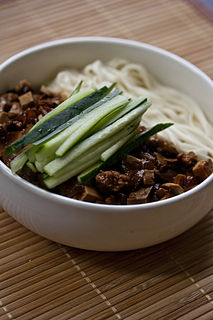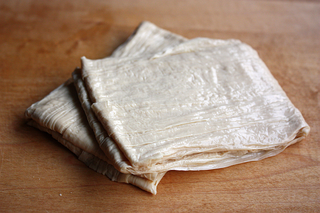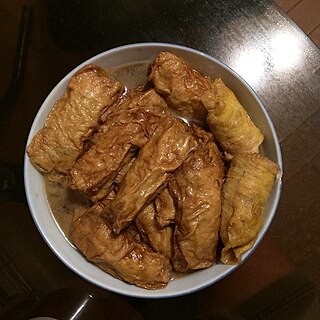
Buddhist cuisine is an Asian cuisine that is followed by monks and many believers from areas historically influenced by Mahayana Buddhism. It is vegetarian or vegan, and it is based on the Dharmic concept of ahimsa (non-violence). Vegetarianism is common in other Dharmic faiths such as Hinduism, Jainism and Sikhism, as well as East Asian religions like Taoism. While monks and a minority of believers are vegetarian year-round, many believers follow the Buddhist vegetarian diet for celebrations.

Chinese cuisine encompasses the numerous cuisines originating from China, as well as overseas cuisines created by the Chinese diaspora. Because of the Chinese diaspora and historical power of the country, Chinese cuisine has influenced many other cuisines in Asia and beyond, with modifications made to cater to local palates. Chinese food staples such as rice, soy sauce, noodles, tea, chili oil, and tofu, and utensils such as chopsticks and the wok, can now be found worldwide.

Vegetarian cuisine is based on food that meets vegetarian standards by not including meat and animal tissue products. Lacto-ovo vegetarianism includes eggs and dairy products. Lacto vegetarianism includes dairy products but not eggs, and ovo vegetarianism encompasses eggs but not dairy products. The strictest form of vegetarianism is veganism, which excludes all animal products, including dairy, honey, and some refined sugars if filtered and whitened with bone char. There are also partial vegetarians, such as pescetarians who eat fish but avoid other types of meat.

Seitan is a food made from gluten, the main protein of wheat. It is also known as miànjīn, fu, milgogi, wheat meat, gluten meat, vital wheat gluten or simply gluten. It is made by washing wheat flour dough with water until all the starch granules have been removed, leaving the sticky insoluble gluten as an elastic mass, which is then cooked before being eaten.

A meat alternative or meat substitute is a food product made from vegetarian or vegan ingredients, eaten as a replacement for meat. Meat alternatives typically approximate qualities of specific types of meat, such as mouthfeel, flavor, appearance, or chemical characteristics. Plant- and fungus-based substitutes are frequently made with soy, but may also be made from wheat gluten as in seitan, pea protein as in the Beyond Burger, or mycoprotein as in Quorn.

Zhajiangmian, literally "fried sauce noodles", commonly translated as "noodles served with fried bean sauce", is a Chinese dish consisting of thick wheat noodles topped with zhajiang sauce. Zhajiang sauce is normally made by simmering stir-fried diced meat or ground pork or beef with salty fermented soybean paste. Zhajiang also means "fried sauce" in Chinese. Even though the sauce itself is made by stir-frying, this homonym does not carry over into the Classical Chinese term.

Tofu skin, Yuba, beancurd skin, beancurd sheet, or beancurd robes is a food product made from soybeans. During the boiling of soy milk, in an open shallow pan, a film or skin composed primarily of a soy protein-lipid complex forms on the liquid surface. The films are collected and dried into yellowish sheets known as tofu skin. Since tofu skin is not produced using a coagulant, it is not technically a proper tofu; however, it does have similar texture and flavor to some tofu products.

Malaysian Chinese cuisine is derived from the culinary traditions of Chinese Malaysian immigrants and their descendants, who have adapted or modified their culinary traditions under the influence of Malaysian culture as well as immigration patterns of Chinese to Malaysia. Because the vast majority of Chinese Malaysians are descendants of immigrants from southern China, Malaysian Chinese cuisine is predominantly based on an eclectic repertoire of dishes with roots from Fujian, Cantonese, Hakka and Teochew cuisines.

Noodle soup refers to a variety of soups with noodles and other ingredients served in a light broth. Noodle soup is a common dish across East Asia, Southeast Asia and the Himalayan states of South Asia. Various types of noodles are used, such as rice noodles, wheat noodles and egg noodles.

Chinese Indonesian cuisine is characterized by the mixture of Chinese with local Indonesian style. Chinese Indonesians, mostly descendant of Han ethnic Hokkien and Hakka speakers, brought their legacy of Chinese cuisine, and modified some of the dishes with the addition of Indonesian ingredients, such as kecap manis, palm sugar, peanut sauce, chili, santan and local spices to form a hybrid Chinese-Indonesian cuisine. Some of the dishes and cakes share the same style as in Malaysia and Singapore which are known as the Nonya cuisine by the Peranakan.

Japanese cuisine has a vast array of regional specialities known as kyōdo ryōri (郷土料理) in Japanese, many of them originating from dishes prepared using local ingredients and traditional recipes.

Bai ye is a main ingredient of some traditional Chinese dishes, such as bean curd skin roll that is widely known in southern regions of China and some of north regions of China and bean curd knot (Chinese:百叶结). Tofu skin is a kind of pressed tofu. In China, pressed tofu comes in myriad shapes, sizes, and texture. Producers make tofu skin by pressing bean curds under much pressure.

Javanese cuisine is the cuisine of Javanese people, a major ethnic group in Indonesia, more precisely the province of Central Java, Yogyakarta and East Java.

Tofu, also known as bean curd in English, is a food prepared by coagulating soy milk and then pressing the resulting curds into solid white blocks of varying softness; it can be silken, soft, firm, extra firm or super firm. Beyond these broad textural categories, there are many varieties of tofu. It has a subtle flavor, so it can be used in savory and sweet dishes. It is often seasoned or marinated to suit the dish and its flavors, and due to its spongy texture, it absorbs flavors well.

Hot and sour soup - is a popular example of Sichuan cuisine. Similar versions derive from Henan province, near Beijing, and from Henan cuisine itself, where it may also be known as Hulatang, or "Pepper Hot Soup" (胡辣汤)..

Hot pot or hotpot, also known as soup-food or steamboat, is a cooking method that originated in China. A heat source on the dining table keeps a pot of soup stock simmering, and a variety of Chinese foodstuffs and ingredients are served beside the pot for the diners to put into the hot stock.

Teochew porridge is a Teochew rice porridge dish often accompanied with various small plates of side dishes. Teochew porridge is served as a banquet of meats, fish egg, and vegetables that is eaten with plain rice porridge. It may be simply prepared plain, or include sweet potatoes. The rice grains, while softened from cooking, are still whole and not in an overly starchy state. Because the porridge is served plain, it is suitable to accompany salty side dishes. The recipe originated in Chaozhou and was later modified by early immigrants prepared in Malaysia and Singapore over the generations to suit local tastes.
















